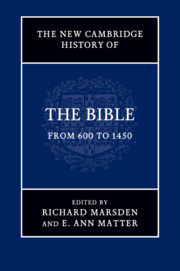Book contents
- Frontmatter
- Contents
- Figures
- Contributors
- Preface
- Abbreviations
- Abbreviations of books of the Bible
- Table of Psalm numbering
- Introduction
- Part I Texts and Versions
- Part II Format and Transmission
- 17 The Bibles of the Christian East
- 18 Carolingian Bibles
- 19 The Latin gospelbook, c. 600–1200
- 20 The Glossed Bible
- 21 The thirteenth century and the Paris Bible
- 22 Romanesque display Bibles
- 23 Latin and vernacular Apocalypses
- 24 The Latin psalter
- 25 Illustration in biblical manuscripts
- Part III The Bible Interpreted
- Part IV The Bible in Use
- Part V The Bible Transformed
- Bibliography
- Index of biblical manuscripts
- Index of scriptural sources
- General index
- References
17 - The Bibles of the Christian East
from Part II - Format and Transmission
Published online by Cambridge University Press: 28 May 2012
- Frontmatter
- Contents
- Figures
- Contributors
- Preface
- Abbreviations
- Abbreviations of books of the Bible
- Table of Psalm numbering
- Introduction
- Part I Texts and Versions
- Part II Format and Transmission
- 17 The Bibles of the Christian East
- 18 Carolingian Bibles
- 19 The Latin gospelbook, c. 600–1200
- 20 The Glossed Bible
- 21 The thirteenth century and the Paris Bible
- 22 Romanesque display Bibles
- 23 Latin and vernacular Apocalypses
- 24 The Latin psalter
- 25 Illustration in biblical manuscripts
- Part III The Bible Interpreted
- Part IV The Bible in Use
- Part V The Bible Transformed
- Bibliography
- Index of biblical manuscripts
- Index of scriptural sources
- General index
- References
Summary
In 615/16, Thomas of Harqel revised the Syriac text of the New Testament, noting after the Gospels:
This book is of the four holy evangelists, which was translated from the Greek language into the Syriac with much accuracy and great labour… And it was revised afterwards with much care by me, the poor Thomas, on [the basis of] three Greek manuscripts, which [were] very approved and accurate, at the Enaton of Alexandria, the great city, in the holy Convent of the Enatonians; where also I wrote it for myself – for the profit of my sinful soul and of the many who love and desire to know and to keep the profitable accuracy of divine books.
Similar enterprises, not always expressly recorded, were periodically undertaken at multinational monastic centres such as the Egyptian convent where Thomas worked, Mt Athos in northern Greece, or the Black Mountain near Antioch. Successive revisions mark the entire medieval history of Christian scriptural translations in the East. The revisers’ invariable aim was to ‘keep the profitable accuracy of divine books’ by bringing their biblical text into closer agreement with the Greek one. The latter carried the authority of an original for all east Christian versions of the Bible, including those which, like the Armenian, Arabic or Ethiopian ones, were at first partly based on other languages. Hardly any Christian translations of the Old Testament were made from Hebrew.
- Type
- Chapter
- Information
- The New Cambridge History of the Bible , pp. 309 - 324Publisher: Cambridge University PressPrint publication year: 2012
References
- 5
- Cited by

